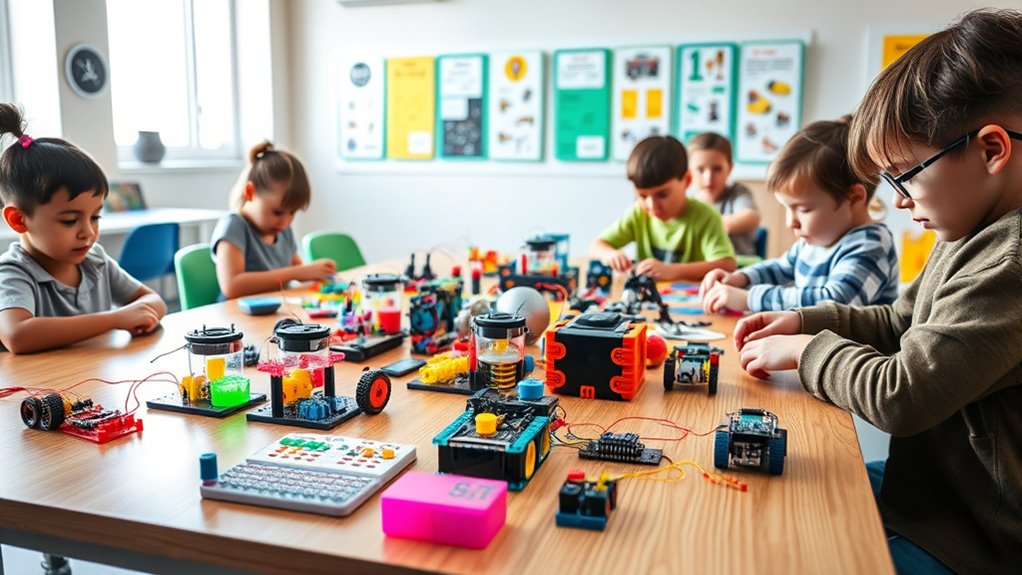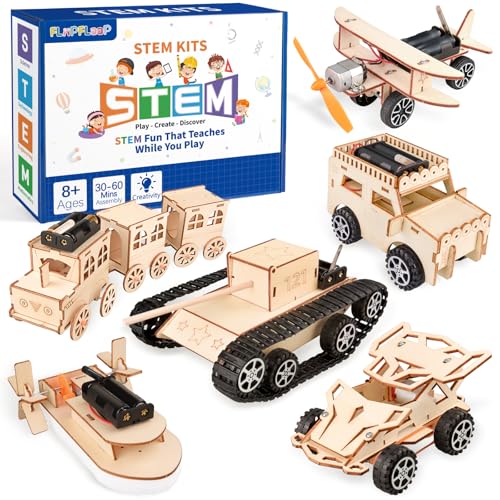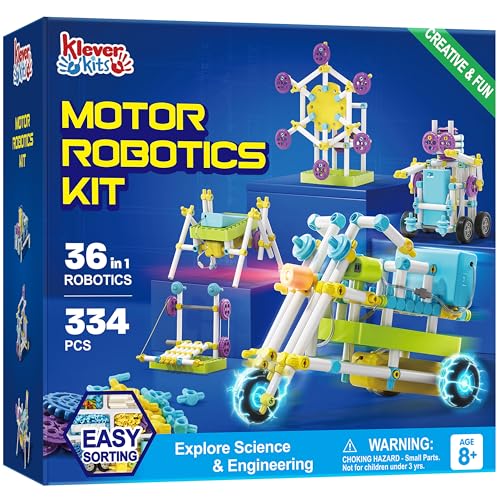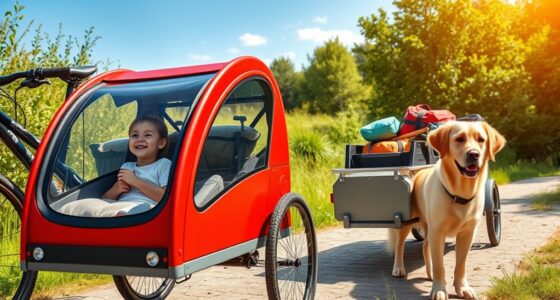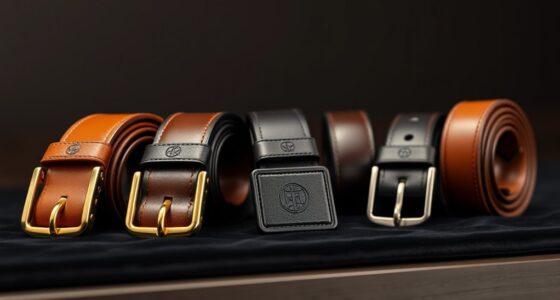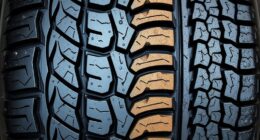If you’re looking for the best educational STEM kits that make learning fun and engaging, I’ve found some great options like Snap Circuits for electronics, Sillbird’s solar robots, and the National Geographic Earth Science kit, which introduces geology through hands-on experiments. There are kits for all ages and interests, from early science with Doctor Jupiter to robot-building with Klever Kits. Keep exploring to see which kits can inspire curiosity and develop essential skills in your child.
Key Takeaways
- Highlights a variety of engaging STEM kits suitable for different ages and interests, promoting interactive and hands-on learning.
- Emphasizes kits that develop key skills like critical thinking, creativity, engineering, and scientific inquiry.
- Includes options with safe materials, easy assembly, and educational content for fun, independent exploration.
- Covers kits focused on topics like electronics, robotics, earth sciences, and eco-friendly projects.
- Provides insights into features, educational benefits, and suitability for family, homeschool, or classroom use.
Snap Circuits Jr. SC-100 Electronics Exploration Kit
If you’re looking for a STEM kit that’s perfect for beginners and young learners, the Snap Circuits Jr. SC-100 Electronics Exploration Kit is an excellent choice. It offers over 100 projects with 28 colorful parts and a full-color manual, making it easy to start right away. Designed for kids aged 8 and up, it helps build practical skills and understanding of circuitry without soldering or tools. The snap-together pieces are color-coded and numbered, simplifying assembly and making learning fun. Whether creating alarms or flying saucers, kids develop creativity and problem-solving skills while exploring the basics of electronics.
Sillbird 12-in-1 Solar Robot Building Kit for Kids
Looking for a STEM kit that combines hands-on building with renewable energy learning? The Sillbird 12-in-1 Solar Robot Building Kit is perfect for kids aged 8-13 who love DIY projects. It includes 190 parts to create 12 models like robots and cars, with varying difficulty levels. The large solar panel teaches kids about solar power and sustainability, using sunlight or artificial light. Clear instructions make assembly easy, though some parts can be tricky or fragile. While solar efficiency depends on sunlight, the kit promotes problem-solving and engineering skills. Overall, it’s a fun, educational way to explore renewable energy and develop STEM abilities.
Best For: Kids aged 8-13 who enjoy hands-on STEM activities and are interested in renewable energy concepts.
Pros:
- Provides engaging, screen-free DIY building experience that fosters creativity and engineering skills.
- Teaches renewable energy principles using a large solar panel for outdoor and indoor play.
- Offers multiple models with varying difficulty levels to support progressive learning and skill development.
Cons:
- Some parts can be small, fragile, and difficult to assemble, requiring tools like pliers and filing.
- Solar panel effectiveness is limited by sunlight intensity, reducing functionality indoors or on cloudy days.
- Assembly quality issues such as parts cracking or not fitting well can affect durability and model performance.
Poraxy 4-in-1 STEM Kits for Kids
Poraxy 4-in-1 STEM Kits are perfect for kids aged 8 to 13 who love hands-on, creative projects. These kits include parts to build a mini ferris wheel, carousel, fiber optic lamp, and star night light, making learning engaging and fun. Crafted from high-quality, laser-cut wood, they’re easy to assemble and can be painted or decorated to personalize each model. The fiber optic lights with color-changing LEDs create magical atmospheres, enhancing the experience. Not only do these kits boost creativity and imagination, but they also develop fine motor skills, hand-eye coordination, and STEM knowledge through interactive building. They’re an ideal gift for curious young learners.
Best For: kids aged 8-13 who enjoy hands-on, educational, and creative STEM projects that can be personalized and decorated.
Pros:
- Made from high-quality, laser-cut wood for easy assembly and durability
- Includes engaging features like fiber optic lights with color-changing LEDs for a magical experience
- Promotes development of fine motor skills, creativity, and STEM knowledge through interactive building
Cons:
- Requires adult supervision for younger children during assembly
- Some parts may be delicate and need careful handling to avoid damage
- Limited to specific models (ferris wheel, carousel, fiber optic lamp, star night light), which may not appeal to all interests
NATIONAL GEOGRAPHIC Earth Science Kit with 100+ Experiments for Kids
The NATIONAL GEOGRAPHIC Earth Science Kit stands out as an ideal choice for curious kids aged 8 and up who want to explore geology and natural phenomena through hands-on experiments. With over 100 activities, including volcano eruptions, crystal growing, and water tornadoes, it keeps kids engaged and learning. The kit features a rock collection with 10 specimens, sparking early geology interests, plus a bonus guide with 85+ experiments using household items. Recognized for quality and educational value, it’s a great way to make earth sciences fun and interactive. Parents and kids alike praise its durability and engaging content, making it a top STEM gift option.
Best For: curious kids aged 8 and up who want to explore earth sciences through engaging, hands-on experiments and activities.
Pros:
- Offers over 100 experiments, including volcano eruptions and crystal growing, providing extensive educational entertainment.
- Includes a rock collection with 10 specimens to foster early interest in geology.
- Recognized for quality and educational value, making it a trusted STEM learning tool.
Cons:
- Some users have reported missing gems or stiffness in certain materials.
- The kit may be limited for very advanced science learners looking for in-depth experiments.
- Requires adult supervision for younger children to ensure safety during experiments.
Doctor Jupiter Science Kit for Kids (Ages 4-8)
If you’re searching for a STEM kit that sparks curiosity in young children, the Doctor Jupiter Science Kit for Kids (Ages 4-8) is an excellent choice. It offers over 100 hands-on experiments that make learning fun and interactive, focusing on concepts like water fireworks and walking water. The kit promotes problem-solving, critical thinking, and independence with clear, easy-to-follow instructions. Safe and high quality, it meets all U.S. safety standards and is perfect for birthdays or holidays. Designed for both girls and boys, it transforms kids into young scientists, inspiring discovery and a love for science that lasts.
Best For: young children aged 4-8 who are curious about science and enjoy hands-on, educational activities.
Pros:
- Offers over 100 engaging experiments to foster early STEM learning
- Includes clear, step-by-step instructions suitable for children and adults
- Meets all U.S. safety standards, ensuring a safe and durable experience
Cons:
- May require adult supervision for younger children during some experiments
- Limited to a specific age range, less suitable for older children
- Some users might need additional materials or space for certain activities
Creativity for Kids Grow N Glow Terrarium Kit
Designed for children aged 6 and up, the Creativity for Kids Grow N’ Glow Terrarium Kit offers an engaging blend of science, art, and responsibility. I love how kids can create their own mini ecosystem inside a mason jar, combining planting, decorating, and observing plant growth. The kit includes everything needed—seeds, soil, decorative accents, and glow-in-the-dark elements—making setup simple and fun. It encourages kids to learn about plant biology, ecosystems, and the importance of care while fostering creativity and independence. Plus, the glowing night effect adds a magical touch that keeps children excited about their natural world.
Best For: children aged 6 and up who enjoy hands-on science, arts and crafts, and nature exploration in a fun, educational, and screen-free activity.
Pros:
- Encourages STEM learning, creativity, and responsibility through plant care and decorating.
- Includes all necessary materials for easy setup and replanting, with glow-in-the-dark accents for added magic.
- Promotes outdoor learning and observation of plant growth in a safe, engaging way.
Cons:
- Some users report a strong soil odor upon opening the kit.
- Limited post-assembly activities once the initial plants have grown; replanting is required for continued use.
- The decorative elements and glow-in-the-dark features may be less vibrant or fade over time.
60+ Science Experiment Kit for Kids Ages 5-8
A great choice for young science enthusiasts, the 60+ Science Experiment Kit for Kids Ages 5-8 offers over 60 engaging activities that make learning fun and interactive. It includes experiments like volcanic eruptions, dinosaur egg digging, milk animation, and lava lamps, sparking curiosity and exploration. All necessary materials, tools, and safety goggles are included, with easy-to-follow instructions to guide kids and parents through each experiment. Compact and lightweight, it’s perfect for hands-on learning at home or as a gift. Designed to promote STEM skills, it encourages critical thinking, observation, and problem-solving, making science accessible and exciting for early learners.
Best For: young children aged 5-8 who are curious about science and enjoy hands-on, interactive learning experiences.
Pros:
- Includes over 60 engaging experiments to keep children entertained and stimulated.
- All necessary materials and safety goggles are provided, making setup easy and safe.
- Encourages STEM learning by promoting critical thinking, observation, and problem-solving skills.
Cons:
- May require adult supervision for younger children during some experiments.
- Limited to children within the recommended age range of 5-8 years.
- The compact size might limit the number of experiments or materials for extended use.
Learning Resources STEM Explorers Pixel Art Challenge
The Learning Resources STEM Explorers Pixel Art Challenge stands out as an excellent choice for young children aged 5 and up who enjoy hands-on, screen-free activities. I love how it promotes critical thinking, problem-solving, and spatial reasoning through 10 challenging, double-sided cards that grow with your child. The set of 98 durable foam pieces is perfect for developing fine motor skills and hand-eye coordination, making pattern creation engaging and safe. It also introduces basic coding and math concepts through colorful, tactile activities. Versatile and Montessori-inspired, this kit encourages independent or classroom play, fostering creativity while building essential STEM skills.
Best For: young children aged 5 and up who enjoy hands-on, screen-free STEM activities that promote critical thinking, fine motor skills, and creative problem-solving.
Pros:
- Encourages critical thinking, problem-solving, and spatial reasoning with increasing difficulty challenges
- Develops fine motor skills, hand-eye coordination, and dexterity through tactile piece placement
- Combines art, science, technology, engineering, and math in a versatile, engaging activity
Cons:
- Might require adult supervision for younger children to ensure proper handling of pieces
- Limited to 10 challenge cards, which may lead to repetition over time
- Foam pieces, while durable, could be lost or misplaced if not stored properly
6-in-1 STEM Kits for Kids Age 8-12
If you’re looking for a versatile STEM kit that offers multiple learning experiences in one package, the 6-in-1 STEM Kits for Kids Age 8-12 is an excellent choice. It features six models, including a hydraulic excavator, Newton’s cradle, space model, and more, all made from durable, safe wooden materials. The pre-cut puzzle pieces make assembly easy, and the kit encourages kids to explore physics concepts like motion, energy, and electricity through hands-on experiments. Perfect for fostering curiosity, critical thinking, and creativity, it also promotes family bonding. With engaging projects and quality components, this kit makes STEM learning fun, memorable, and suitable for children 8 and up.
Best For: children aged 8-12 who are interested in hands-on STEM activities that promote learning, creativity, and family bonding.
Pros:
- Offers six diverse models for varied STEM learning experiences, enhancing curiosity and understanding of physics principles.
- Made from durable, safe wooden materials with pre-cut pieces, making assembly straightforward and enjoyable.
- Encourages critical thinking, problem-solving, and creativity while fostering parent-child collaboration and confidence.
Cons:
- Assembly instructions could be clearer, which may require additional patience or adult assistance.
- Requires AA batteries (not included), adding an extra step for setup.
- Some users might find the models less customizable compared to plastic building kits like Legos.
Klever Kits 36-in-1 Motor Robotic Kits for Kids
For parents and educators seeking an engaging STEM activity that combines creativity with hands-on learning, Klever Kits 36-in-1 Motor Robotic Kits stands out as an excellent choice. This kit offers 36 different models, including robots like walking machines and racing cars, perfect for children ages 8-13. It promotes STEM skills through easy-to-follow instructions, video tutorials, and an organized parts tray. Built from safe, durable materials, it encourages screen-free fun, teamwork, and problem-solving. Children can develop fine motor skills, critical thinking, and engineering basics while enjoying the process of building and customizing their robots. It’s a versatile, educational gift that fosters lasting learning and bonding.
Best For: children ages 8-13, parents, and educators seeking an engaging, educational STEM activity that promotes creativity, problem-solving, and teamwork through hands-on robot building.
Pros:
- Offers 36 diverse models to inspire creativity and experimentation
- Enhances STEM skills, including engineering, mechanics, and critical thinking
- Comes with organized parts, clear instructions, and video tutorials for an easy assembly experience
Cons:
- Some users report difficulty with battery pack assembly and motor orientation
- Color mismatches between parts and instructions can cause confusion during building
- May be challenging for younger children or those with limited building experience
Dan&Darci Light-Up Terrarium Kit for Kids
Children aged 6-12 will love the Dan&Darci Light-Up Terrarium Kit because it combines hands-on science with mesmerizing visual effects. This kit lets kids create a miniature garden inside a jar, teaching them about plant growth, ecology, and creativity. The built-in LED light makes their terrarium glow at night, adding a magical touch. Kids can decorate with stickers and arrange rocks, sand, and soil, making each project unique. The clear instructions and simple assembly process make it easy and fun to grow their own tiny ecosystem. It’s a perfect gift that sparks curiosity, fosters learning, and provides a captivating illuminated display.
Best For: children aged 6-12 who are interested in hands-on science, gardening, and creative play, making learning fun and engaging.
Pros:
- Encourages STEM learning through plant growth and ecology exploration
- Features a built-in LED light for a magical illuminated nighttime display
- Includes all necessary components for easy assembly and customization
Cons:
- May require adult supervision for younger children during assembly
- Limited to small-scale miniatures, which might not appeal to all interests
- Battery life of the LED light could be limited with frequent use
UNGILINGA 70 Lab Experiments Science Kits for Kids
The UNGILINGA 70 Lab Experiments Science Kits stand out as an excellent choice for parents and educators seeking engaging, hands-on STEM activities that foster critical thinking and problem-solving. With 70 experiments like volcano eruptions, crystal growing, balloon rockets, and fruit circuits, it offers a thorough science experience. The kit’s child-friendly ingredients ensure safety for kids aged 8 and up, promoting independent learning and teamwork. Its clear instructions and variety keep children curious and engaged, making science fun and accessible. Whether for classroom use or family bonding, this kit provides hours of educational entertainment that builds foundational science and math skills.
Best For: parents, educators, and kids aged 8 and above seeking a comprehensive, safe, and engaging STEM learning experience through hands-on science experiments.
Pros:
- Offers 70 diverse and engaging experiments to stimulate curiosity and critical thinking
- Child-friendly ingredients ensure safety and promote independent learning
- Clear instructions and quality components make it suitable for homeschool, classroom, or family use
Cons:
- Some experiments may require additional household items like lemons or flour
- Certain components, such as beakers, need careful handling and are not dishwasher safe
- Shorter or simpler experiments might not hold the attention span of all children for extended periods
Sntieecr Electric Circuit Motor Kit for Kids
If you’re looking for a hands-on STEM kit that makes learning about electricity fun and accessible, the Sntieecr Electric Circuit Motor Kit stands out as an excellent choice for kids aged 8 and above. It comes with a variety of components like motors, switches, bulbs, and propellers, allowing children to build and experiment with electrical circuits easily. The clear instructions and versatile parts encourage creativity, critical thinking, and problem-solving. Plus, the durable design guarantees long-lasting use. This kit is perfect for science projects, classroom activities, or engaging at-home learning, inspiring young minds to explore electronics and engineering confidently.
Best For: parents, teachers, and young learners aged 8 and above interested in hands-on STEM education and basic electronics exploration.
Pros:
- Encourages creativity, critical thinking, and problem-solving skills through practical building activities.
- Comes with comprehensive components and clear instructions suitable for beginners.
- Durable, versatile, and ideal for classroom, home, and science project use.
Cons:
- Small instruction pamphlet may be insufficient for detailed guidance.
- Some components, like bulbs or wires, may occasionally malfunction or not work properly.
- Safety concerns such as sparks or melted wires during experiments require adult supervision.
STEM Electric Circuit Kit for Kids (Ages 8-12)
For ages 8 to 12, the STEM Electric Circuit Kit offers an engaging way to explore electrical concepts through hands-on experiments. It includes 8 different projects across 7 packs, such as series and parallel circuits, saltwater power generation, and fruit batteries. The kit comes with a detailed Circuit Book with easy-to-follow instructions suitable for young learners. It promotes critical thinking, problem-solving, and creativity while helping kids understand conductivity, energy transfer, and basic electrical engineering principles. Perfect for home, school, or science fairs, this kit makes learning about electricity fun, interactive, and accessible for children aged 6 to 12.
Best For: children aged 8 to 12 who are interested in learning about electricity through hands-on experiments at home or school.
Pros:
- Offers 8 engaging experiments covering various electrical principles, including series and parallel circuits.
- Comes with a detailed, easy-to-follow Circuit Book suitable for young learners.
- Promotes critical thinking, creativity, and understanding of electrical concepts in a fun, interactive way.
Cons:
- Requires AA batteries, which are not included in the kit.
- May be too advanced for children younger than 6 without adult supervision.
- Limited to 8 experiments, which might not satisfy more advanced or curious learners seeking more extensive projects.
UNGLINGA Science Lab Experiments Kit for Kids
Looking for a STEM kit that keeps kids engaged with hands-on experiments and sparks curiosity? The UNGLINGA Science Lab Experiments Kit offers over 50 exciting activities, including volcanoes, gemstone creation, and rainbow rain. It promotes critical thinking, problem-solving, and scientific understanding through fun experiments that explain earth sciences, chemistry, and magic. The detailed, easy-to-follow guide makes learning accessible, even for younger children with supervision. Made of high-quality materials, this kit is perfect for family sharing or classroom use. It’s a fantastic way to ignite a child’s love for science while providing hours of educational entertainment.
Best For: parents, teachers, and children aged 8 and up who want an engaging, educational STEM kit that fosters curiosity, critical thinking, and hands-on learning through fun experiments.
Pros:
- Offers over 50 diverse science activities that cover earth sciences, chemistry, and magic, providing extensive educational entertainment.
- Includes a detailed, easy-to-follow manual that explains the science behind each experiment, enhancing understanding and engagement.
- Made of high-quality materials, suitable for sharing with family and friends, and promotes collaborative learning experiences.
Cons:
- Some experiments may require parental preparation and supervision to ensure safety and proper setup.
- Younger children (under 8) may need assistance to fully enjoy and understand the activities.
- The kit’s size and contents might limit portability for outdoor or on-the-go use.
Factors to Consider When Choosing Educational STEM Kits for Kids
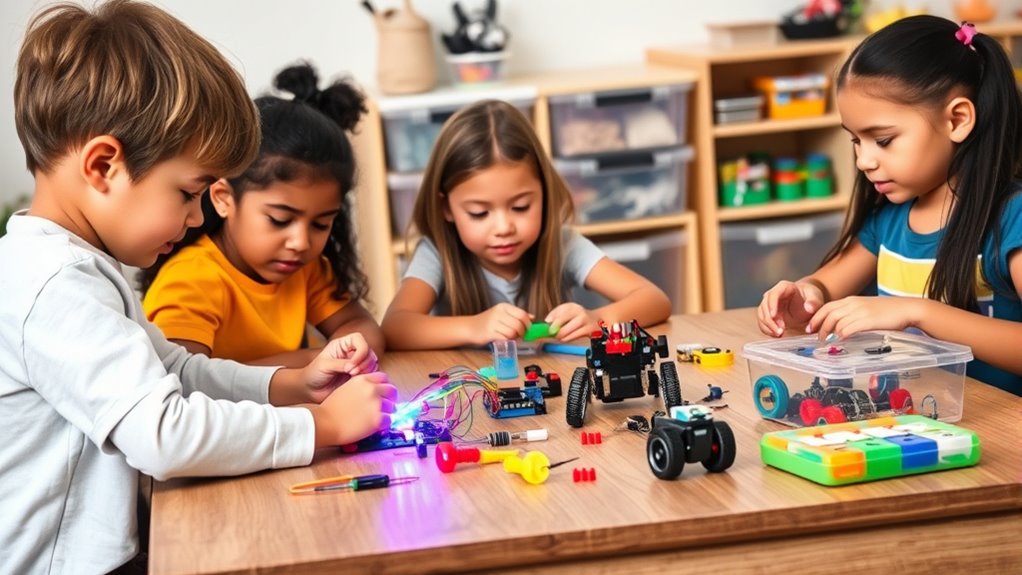
When choosing a STEM kit for kids, I always consider their age to guarantee the activities are suitable and engaging. Safety standards and material durability are essential to keep them safe during play, while the educational focus helps me pick kits that foster curiosity. Finally, I look at assembly complexity to match their skill level and keep the experience enjoyable.
Age Appropriateness
Choosing the right STEM kit depends heavily on matching it to a child’s developmental level, ensuring they stay engaged without feeling overwhelmed. Make sure the kit’s recommended age range aligns with your child’s age and skills. Kits for ages 8 and up usually include more complex components and instructions suited for older children’s abilities. For younger kids, look for kits with simple, large parts and clear, illustrated instructions that promote independent exploration. It’s important to contemplate whether the activities match your child’s current interests and learning stage, which helps maintain their enthusiasm. Additionally, always check that the kit meets safety standards, especially for younger children—avoiding small parts or materials that could pose choking hazards. Proper age-appropriate kits make learning safe, fun, and rewarding.
Educational Focus
Ever wonder what makes a STEM kit truly educational? I believe it’s about more than just fun projects; it’s ensuring the kit promotes core STEM skills like problem-solving, critical thinking, and scientific understanding. The content should challenge kids appropriately for their age and development level, encouraging them to explore and discover. Look for kits with clear, step-by-step instructions and educational materials that explain the science behind each activity. Hands-on experiences are essential—they foster curiosity and inquiry, helping kids learn by doing. The focus should be on building a solid foundation in science, technology, engineering, and math, rather than just entertaining. An educational STEM kit should inspire kids to ask questions and develop a genuine interest in these fields.
Assembly Complexity
Assembly complexity plays a crucial role in selecting the right STEM kit, as it directly impacts a child’s engagement and learning experience. Kits with simple snap-together parts are perfect for younger kids or beginners, reducing frustration and keeping them motivated. On the other hand, more complex kits involving multiple steps, small parts, or tools can deepen understanding and develop fine motor skills but may also require adult supervision. Clear, detailed instructions and visual guides make assembly more manageable, especially for children learning independence. When choosing a kit, I consider the child’s age, patience, and dexterity to match the complexity level appropriately. A well-balanced kit challenges without overwhelming, fostering both confidence and curiosity in STEM learning.
Material Durability
Since kids will be handling STEM kits frequently, selecting durable materials is essential to guarantee the components last through repeated use. High-quality plastics, metals, or wood help assure parts withstand constant assembly, disassembly, and active handling without breaking or wearing out quickly. Sturdy construction is especially important for kits designed for younger children, who tend to apply more force during play. Durable materials not only extend the lifespan of the kit but also reduce the need for replacements, offering better value. Additionally, choosing materials that meet safety standards, like BPA-free plastics or non-toxic finishes, protects kids’ health while they learn. Well-made components minimize cracking, snapping, or loosening, supporting continuous educational activities and maintaining the integrity of the learning experience over time.
Safety Standards
Choosing a STEM kit for kids isn’t just about fun and learning—it’s vital to prioritize safety standards to protect young users. I always look for kits that comply with ASTM F963-17 safety standards and include non-toxic, child-safe materials. Packaging should feature clear age warnings and choking hazard labels, especially if small parts are involved. I verify that electrical components are properly insulated and meet safety certifications to avoid shocks or short circuits. It’s also essential that the kit provides straightforward safety instructions and supervision guidelines to minimize risks during experiments. Finally, I prefer kits made from durable, high-quality materials designed to withstand handling without breaking or causing injury. These precautions help ensure a safe, enjoyable learning experience for kids.
Frequently Asked Questions
What Safety Features Should I Look for in STEM Kits for Young Children?
When choosing STEM kits for young children, I look for safety features like non-toxic materials and age-appropriate parts. I make sure the kit has clear instructions and small parts are securely attached to prevent choking hazards. It’s also important that the kit is sturdy and well-made, with no sharp edges. These features give me peace of mind knowing my child can explore and learn safely.
Are There Eco-Friendly or Sustainable STEM Kits Available for Kids?
Think of eco-friendly STEM kits like a refreshing gust for young explorers. Yes, many sustainable options are available, made from biodegradable or recycled materials, reducing environmental impact. I recommend looking for kits labeled as eco-conscious or sustainable. These kits often feature non-toxic components and packaging that’s kind to the planet. They’re perfect for encouraging kids’ curiosity while teaching them the importance of caring for our environment.
How Do STEM Kits Support Different Learning Styles and Abilities?
STEM kits support different learning styles and abilities by offering hands-on activities, visual aids, and step-by-step instructions that cater to diverse needs. I’ve seen them engage tactile learners with physical building projects, while visual learners benefit from diagrams and videos. They also encourage problem-solving and creativity, helping kids with varying abilities build confidence and understanding at their own pace. It’s all about making learning accessible and fun for everyone.
Can These Kits Be Used for Group or Classroom Learning Environments?
Absolutely, these STEM kits are perfect for group or classroom settings. I’ve seen how they foster collaboration, spark curiosity, and encourage teamwork among kids. They’re designed to be engaging for multiple learners at once, making them ideal for hands-on activities. Plus, the variety of projects helps accommodate different learning styles, ensuring everyone stays involved and excited about exploring science, technology, engineering, and math together.
What Are the Recommended Age Ranges for More Advanced STEM Kits?
Think of advanced STEM kits as a rocket ready for launch—they’re best suited for kids aged 10 and up. These kits often include complex projects that challenge young explorers, helping them reach new heights in learning. I recommend checking each kit’s age guidelines to make certain they match your child’s skill level. With the right kit, your child can truly soar into the fascinating world of science and engineering.
Conclusion
Just like Alice’s curiosity in Wonderland, these STEM kits open a world of discovery and fun. Whether your kid’s a budding scientist or future engineer, these kits turn learning into an adventure. With the right choice, you’ll inspire a love for exploration that lasts a lifetime. So, immerse yourself and let their imagination soar—because, after all, every great scientist started with a single curious step.
